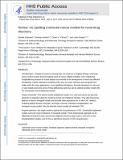Colorectal cancer models for novel drug discovery
Author(s)
Golovko, Daniel; Kedrin, Dmitriy; Yilmaz, Omer; Roper, Jatin
DownloadYilmaz_Review US spelling.pdf (1.511Mb)
OPEN_ACCESS_POLICY
Open Access Policy
Creative Commons Attribution-Noncommercial-Share Alike
Terms of use
Metadata
Show full item recordAbstract
Introduction: Despite increased screening rates and advances in targeted therapy, colorectal cancer (CRC) remains the third leading cause of cancer-related mortality. CRC models that recapitulate key features of human disease are essential to the development of novel and effective
therapeutics. Classic methods of modeling CRC such as human cell lines and xenograft mice, while useful for many applications, carry significant limitations. Recently developed in vitro and in vivo models overcome some of these deficiencies and thus can be utilized to better model CRC
for mechanistic and translational research.
Areas Covered; The authors review established models of in vitro cell culture and describe advances in organoid culture for studying normal and malignant intestine. They also discuss key features of classic xenograft models and describe other approaches for in vivo CRC research,
including patient-derived xenograft, carcinogen-induced, orthotopic transplantation, and transgenic mouse models. We also describe mouse models of metastatic CRC.
Expert opinion: No single model is optimal for drug discovery in CRC. Genetically engineered models overcome many limitations of xenograft models. Three-dimensional organoids can be efficiently derived from both normal and malignant tissue for large-scale in vitro and in vivo
(transplantation) studies, and are thus a significant advance in CRC drug discovery.
Date issued
2015-08Department
Massachusetts Institute of Technology. Department of Biology; Koch Institute for Integrative Cancer Research at MITJournal
Expert Opinion on Drug Discovery
Publisher
Informa Healthcare
Citation
Golovko, Daniel et al. “Colorectal Cancer Models for Novel Drug Discovery.” Expert Opinion on Drug Discovery 10.11 (2015): 1217–1229.
Version: Author's final manuscript
ISSN
1746-0441
1746-045X